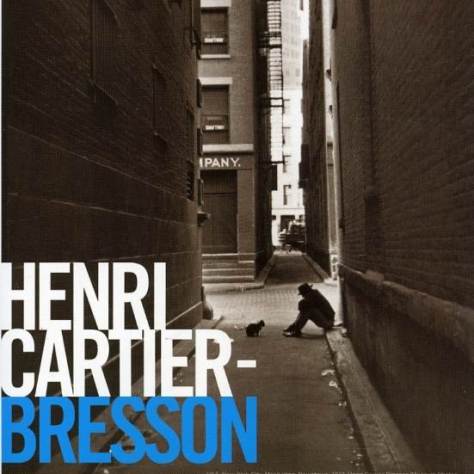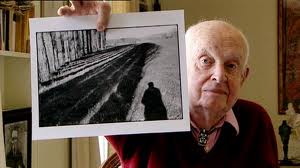
Henri Cartier-Bresson (1908-2004) is considered by many as “the father of photojournalism” and did much to advance his own legend as someone who clicked the shutter at exactly the right moment. There is no question that he shot many sriking images of people, in a very wide variety of places, in often very geometric compositions. I admire many of his portraits of other artists (the documentary “The Impassioned Eye” includes many of Henri Matisse and Pierre Bonnard) and writers (Arthur Miller says nothing about the Cartier-Bresson portrait of himself but praises one Cartier-Bresson took of his deceased wife) and photos of uncelebrated Russian, Mexican, Japanese, Indian, French, Chinese, and American individuals, but most like his pictures of human silhouettes within cityscapes and landscapes.
As a slideshow of Cartier-Bresson photographs and drawings with musical accompaniment from Bach, Mozart, and Ravel, “The Impassioned Eye” would definitely rate 5 stars. Notoriously unwilling to be photographed, it was probably a major accomplishment to get him to appear in a documentary, even doing little more than sitting down looking at old photographs (he largely ceased shooting photos during the early 1970s) and drawings and at some paintings in the Louvre. He says very little about them and rarely shows much reaction to what he holds up. (This reminds me of William Burrough’s quip that Paul Bowles’s unrevealing memoir Without Stopping should have been titled Without Telling (anything anout himself, that is).)

Arthur Miller, Isabelle Huppert, and some photographers less famous than Cartier-Bresson (Ferdinando Scianna, Josef Koudelka) sing his praises, but no one supplies much insight into how he did what he did or any discusses any development (if there was any—the images from the 1930s and those from the 1960s do not have a different look).
There is nothing biographical except a passing mention of his early association with surrealists. Cartier-Bresson praises the red in a Vermeer, opines that drawing the figures of Rubens paintings in the Louvre was good training for him as a youth, tells of meeting Gandhi minutes before he went out and was shot, and suggests that hiding from the Nazis during 1943 had a permanent effect on his own reclusive personality.
I mentioned the legend of Cartier-Bresson. Its influential foundation was built around the 1952 “The Decisive Moment” show (and book). There is no question that Cartier-Bresson had an eye for composition and for framing, but in addition to the legendary instances of shooting at the right moment, he in fact made multiple other shots around the one later printed. The ability to pick out “the decisive moment” was after the fact, picking out the one to print from multiple shots (contact sheets), not just clicking once at “the decisive moment.” This is demonstrated beyond any argument in the recently published (this year) Henri Cartier Bresson Scrapbook from the 1930s and 40s.
One does not expect Cartier-Bresson to have debunked his legend or to have opened up about his life or “processes,” and a slide-show of his work is well worth seeing. But the documentary cannot compete with the ones of Picasso at work (The Mystery of Picasso) or of Alberto Giacometti at work and looking at a retrospective of his work. Also, I wish that there was a choice between subtitles for the French and dubbing into English. Having English dubbing blotting out the French after a few words of each speaker seems to me the worst of both worlds: one wants to hear him in a documentary that is mostly him talking!
Heinz Bütler is credited with directing the 72-minute documentary “Henri Cartier-Bresson: Biographie eines Blicks.” There is no indication of whether he was also the interviewer or when the interviews took place (my best guess is 2002, since the documentary aired on Swiss television in 2003 and is copyrighted that year by Neue Zûrcher Zeitung); the Palm Pictures DVD became available in late 2006.
©2007, 2016, Stephen O. Murray
originally posted on AssociatedContent.com, a site that was bought and obliterated by Yahoo
Also see my review of C-B’s portraits collected in An Inner SIlence.